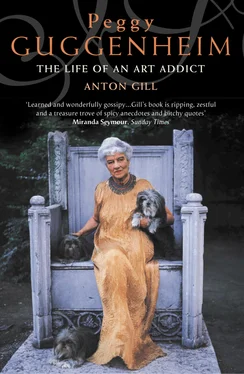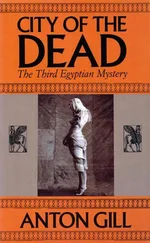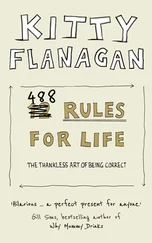Her troubles also made her an intolerable and rude little girl. Ben was not the only one whom she insulted by her outspoken behaviour. She told one of her parents’ friends that she knew her husband had run away from her, and asked another, whose command of English was not perfect, why he couldn’t learn to speak it better. Hazel later reported that Florette tolerated this behaviour adoringly, but she may have been influenced by childhood envy. Both the younger girls desperately needed the attention of an adult: their older sister Benita, calm, beautiful, kind and a little bit remote, was all that was available. Hungrily, they vied for her attention.
On early European tours the two older girls, Peggy and her adored Benita, had their portraits painted in Munich by Franz Lenbach, a well-known and fashionable portraitist. He painted Peggy when she was four, and also did a double portrait of Peggy and Benita a year or so earlier. Peggy, while saying, probably truthfully, that the pictures were ‘the greatest treasures of my past’, also complained that Lenbach ‘gave me brown eyes instead of green, and red hair instead of chestnut’. But the great man was getting on by the time he met Peggy, and by that stage of his career he was increasingly finishing his portraits from photographs, which in those days were black-and-white. The portraits still exist, and are duly stately and decorative. Later in life Peggy, since Lenbach had dated one of them, had an artist friend paint out the date, for fear that people would see it and realise that she was older than she wanted to admit to. Later still, discovering that Lenbach was most famous for his paintings of Bismarck, she had the same friend paint the date back in, for fear that people would think she was older than she was. If this story sounds apocryphal, we have the assurance of the artist concerned, Peter Ruta, that it is not.
While Florette’s meanness got her into trouble with hotel staff – she wouldn’t tip, and that meant porters would mark the family baggage with discreet white crosses to ensure minimal service at their next destination – Ben was still taking care of his daughters’ education. He had their tutor Mrs Hartmann accompany them to Europe on their tour in about 1909. Mrs Hartmann had a wide remit: she took the girls to the main museums of Paris, and to the châteaux of the Loire, in those days not suffering from tourist-saturation. She taught them French history and had them read the English nineteenth-century classics, as well as treating them to ‘a complete course in Wagner’s operas’. Peggy’s mind, however, was elsewhere. She’d fallen for a friend of her father’s called Rudi, who was travelling with them, as Florette was trying to matchmake between him and an older cousin of Peggy’s, also brought along on the trip. Peggy became wildly jealous and wrote a series of letters, sadly lost, in which she went in for expressions like ‘my body was nailed to the fire of the cross’. Despite these effusions – had she been reading The Lustful Turk secretly, along with Dickens and Thackeray and George Eliot? – she was still enough of a little girl to collect wax dolls and dress them, in clothes designed and made by herself, in a manner inspired by the ultra-chic ladies of both the high society and the demi-monde of Trouville.
There were other distractions. While having tea with Benita and their governess at Rumpelmeyer’s in Paris, Peggy couldn’t help noticing a woman at the next table who seemed equally interested in them. She must have had an intuition about the identity of the woman, and she knew her father had a mistress, so that months later, after she’d been on at her governess for some time about the mistress’s identity, and the governess finally replied, ‘You know her,’ Peggy realised she meant the woman at tea.
She was Countess Taverny, whom Peggy refers to as the Marquise de Cerutti in the first edition of her memoirs, and simply as ‘TM’ in the second; and there was more than one embarrassing and unplanned meeting between them. Unsurprisingly, people of fashion and money visited the same shops, and there was a disagreeable encounter between Florette and the Countess at Lanvin’s on one occasion. On another, when Florette was with Ben and they ran into Taverny in the Bois de Boulogne, Florette noticed her rival’s expensive lambswool suit, knew who’d bought it, and protested to her husband at his extravagance. Ben, humbled, gave his wife a similar sum so that she could have a suit made for herself. Florette invested the money instead. But by the time of the Countess, Florette and Ben were virtually estranged. Divorce had already loomed when Ben had fallen for the sister of a brother-in-law, Amy Goldsmith. On that occasion disaster had been averted by the intervention of the Guggenheim family, who dissuaded Ben from being foolhardy, bought Amy off, and placated Florette. But by the time Ben died in 1912 the family had, effectively, broken up.
The Regis Hotel had been a centre for great Guggenheim family get-togethers, a ritual performed every Friday evening; but once Florette had moved out she was set at one remove from the centre of the Guggenheim clan, though she was still part of the family. Naturally for some time the idea of Atlantic crossings – quite apart from the expense – did not appeal, and so the family spent their summers at one or other of the more or less hideous Victorian-Gothic piles Guggenheims and Seligmans had built as country retreats at Jewish resorts just outside Manhattan like Deal Beach, Elberon and West End. Peggy remembered the relatively modest pile belonging to her Seligman grandfather: ‘It was completely surrounded by porches, one on each floor. The porches were covered with rocking chairs where the entire family sat and rocked all day. It was so ugly in its Victorian perfection that it was fascinating.’
This was nothing new; as children they had spent the summers that they did not go to Europe ‘on this horrible [New Jersey] coast’. But the stifling atmosphere of these places bred in Peggy an abiding dislike of America, which was abetted by the still-prevalent anti-Semitism which had forced families like hers into self-imposed wealthy ghettos. Uncle Isaac Guggenheim, refused membership of the Sands Point Bath and Golf Club, built his own nine-hole golf course at his nearby estate of Villa Carola. When the hotel in nearby Allenhurst, which did not admit Jews, burned down one summer, the children watched the conflagration with delight.
By 1913 Florette was taking the girls back over to England to visit her Seligman relatives in Ascot, Berkshire. But then came an interruption to European travel in the form of the First World War.
In the meantime Peggy left off private tuition and started going to the Jacoby School, a private establishment for rich Jewish girls on the west side of Central Park, across which she walked to school every day. It was more of a finishing school than a place of learning, for it was not considered that the girls who attended would ever have to do much; what was important was how to behave, how to be decorative, and how to navigate the intricacies of etiquette and social convention that permeated New York society. Peggy would have quickly become bored if that had been all the place had to offer, but by luck the Jacoby’s drama teacher, Mrs Quaife, took to the mawkish fifteen-year-old, encouraged her to read Browning, and gave her the part of Amy in a school production of Little Women. In addition, Peggy began what was to become a lifelong love affair with books. In her loneliness she had discovered the comforts of literature, and at the Jacoby she became acquainted with, and read and re-read, most of the modern classics, from J.M. Barrie to George Bernard Shaw. More daringly, she also read Ibsen, Strindberg and Wilde, as well as Tolstoy and Turgenev. Soon she would develop a passion for Dostoevsky and Henry James that would never leave her, and in later life she would take periods of illness or enforced inactivity as opportunities to explore new authors such as Lawrence or Proust in depth. These literary interests might have taken her further. For a time she was tempted by the idea of going on to college, but Benita talked her out of it. Benita by now had an odd relationship with her younger sister. Although she was still the object of Peggy’s adoration, it was becoming clear that Peggy was the dominant partner. Peggy took Benita’s advice, but she regretted it. A lifelong autodidact, she always longed to be more learned than she was – or than she perceived herself to be; with her hunger for knowledge, it is a pity that she forewent such a chance.
Читать дальше












